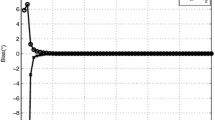Abstract
We analyze the large-sample mean square error (MSE) of MUSIC and Min-Norm direction-of-arrival (DOA) estimators under fairly general conditions, including mismodelling of the array response and the noise covariance. We separate the contributions to the MSE into a bias part caused by modelling errors and a variance part caused by finite (yet large) sample effects. The bias is simply evaluated by comparing the limiting estimate (corresponding to an infinite number of snapshots) with the true DOAs (which are known to the analyzer). To simplify the variance derivation we assume that the snapshots are complex i.i.d. Gaussian vectors and that the largest eigenvalues of their covariance matrix are distinct, but,otherwise, make none of the assumptions commonly used in previous analyses; in particular we do not constrain the snapshots to satisfy any model equation. The theoretical results obtained are illustrated by means of numerical examples using various modelling errors.
Similar content being viewed by others
References
A. J. Barabell, Improving the resolution performance of eigenstructure-based direction-finding algorithms, inProc. of the International Conference on Acoustics, Speech, and Signal Processing, pp. 336–339, Boston, MA, April 1983.
B. Friedlander, A sensitivity analysis of the MUSIC algorithm,IEEE Transactions on Acoustics, Speech, and Signal Processing, vol. ASSP-38, no. 10, pp. 1740–1751, October 1990.
B. Friedlander, On the sensitivity of covariance based direction finding to gain and phase perturbations, inProc. of the International Conference on Acoustics, Speech, and Signal Processing, pp. 445–448, San Francisco, CA, March 1992.
P. H. Janssen and P. Stoica, On the expectation of the product of four matrix-valued Gaussian random variables,IEEE Transactions on Automatic Control, vol. AC-33, no. 9, pp. 867–870, September 1988.
A. Kangas, Contributions to temporal and spatial frequency estimation, Ph.D. thesis, Systems and Control Group, Uppsala University, 1993.
M. Kaveh and A. J. Barabell, The statistical performance of the MUSIC and the Minimum-Norm algorithms in resolving plane waves in noise,IEEE Transactions on Acoustics, Speech, and Signal Processing, vol. ASSP-34, no. 2, pp. 331–341, April 1986.
H. Krim, P. Forster, and J. G. Proakis, Operator approach to performance analysis of Root-MUSIC and Root-Min-Norm,IEEE Transactions on Signal Processing, vol. SP-40, no. 7, pp. 1687–1695, July 1992.
R. Kumaresan and D. W. Tufts, Estimating the angle of arrival of multiple plane waves,IEEE Transactions on Aerospace and Electronic Systems, vol. AES-19, no. 1, pp. 134–139, January 1983.
F. Li and R. J. Vaccaro, Unified analysis for DOA estimation algorithms in array signal processing,Signal Processing, vol. 25, no. 11, pp. 147–169, November 1991.
F. Li and R. J. Vaccaro, Performance degradation of DOA estimators due to unknown noise fields,IEEE Transactions on Signal Processing, vol. 40, no. 3, pp. 686–690, March 1992.
F. Li and R. J. Vaccaro, Sensitivity analysis of DOA estimation algorithms to sensor errors,IEEE Transactions on Aerospace and Electronic Systems, vol. 28, no. 3, pp. 708–717, July 1992.
B. Porat and B. Friedlander, Analysis of the asymptotic relative efficiency of the MUSIC algorithm,IEEE Transactions on Acoustics, Speech, and Signal Processing, vol. ASSP-36, no. 4, pp. 532–543, April 1988.
B. D. Rao and K. V. S. Hari, Performance analysis of Root-MUSIC,IEEE Transactions on Acoustics, Speech, and Signal Processing, vol. ASSP-37, no. 12, pp. 1939–1949, December 1989.
R. O. Schmidt, Multiple emitter location and signal parameter estimation,IEEE Transactions on Antenna and Propagation, vol. AP-34, pp. 276–280, March 1986.
T. Söderström and P. Stoica,System Identification, Prentice Hall International, Hemel Hempstead, UK, 1989.
P. Stoica and A. Nehorai, MUSIC, maximum likelihood, and Cra'er-Rao bound,IEEE Transactions on Acoustics, Speech, and Signal Processing, vol. ASSP-37, no. 5, pp. 720–741, May 1989.
P. Stoica and A. Nehorai, MUSIC, maximum likelihood, and Cramér-Rao bound: Further results and comparisons,IEEE Transactions on Acoustics, Speech, and Signal Processing, vol. ASSP-38, no. 12, pp. 2140–2150, December 1990.
A. L. Swindlehurst, Applications of subspace fitting to estimation and identification, Ph.D. thesis, Stanford University, June 1991.
A. L. Swindlehurst and T. Kailath, A performance analysis of subspace-based methods in the presence of model errors, part I: The MUSIC algorithm,IEEE Transactions on Signal Processing, vol. SP-40, no. 7, pp. 1758–1774, July 1992.
M. Viberg, Effects of unknown noise covariance on parametric array processing algorithms, inProceedings of the 9th IFAC/IFORS Symposium on Identification and System Parameter Estimation, pp. 1392–1397, Budapest, Hungary, July 1991.
Author information
Authors and Affiliations
Additional information
The work of Petre Stoica was supported by the Swedish Research Council of Engineering Sciences under contract 91-676.
Rights and permissions
About this article
Cite this article
Kangas, A., Stoica, P. & Söderström, T. Large-sample analysis of MUSIC and Min-Norm direction estimators in the presence of model errors. Circuits Systems and Signal Process 15, 377–393 (1996). https://doi.org/10.1007/BF01182593
Received:
Accepted:
Issue Date:
DOI: https://doi.org/10.1007/BF01182593




